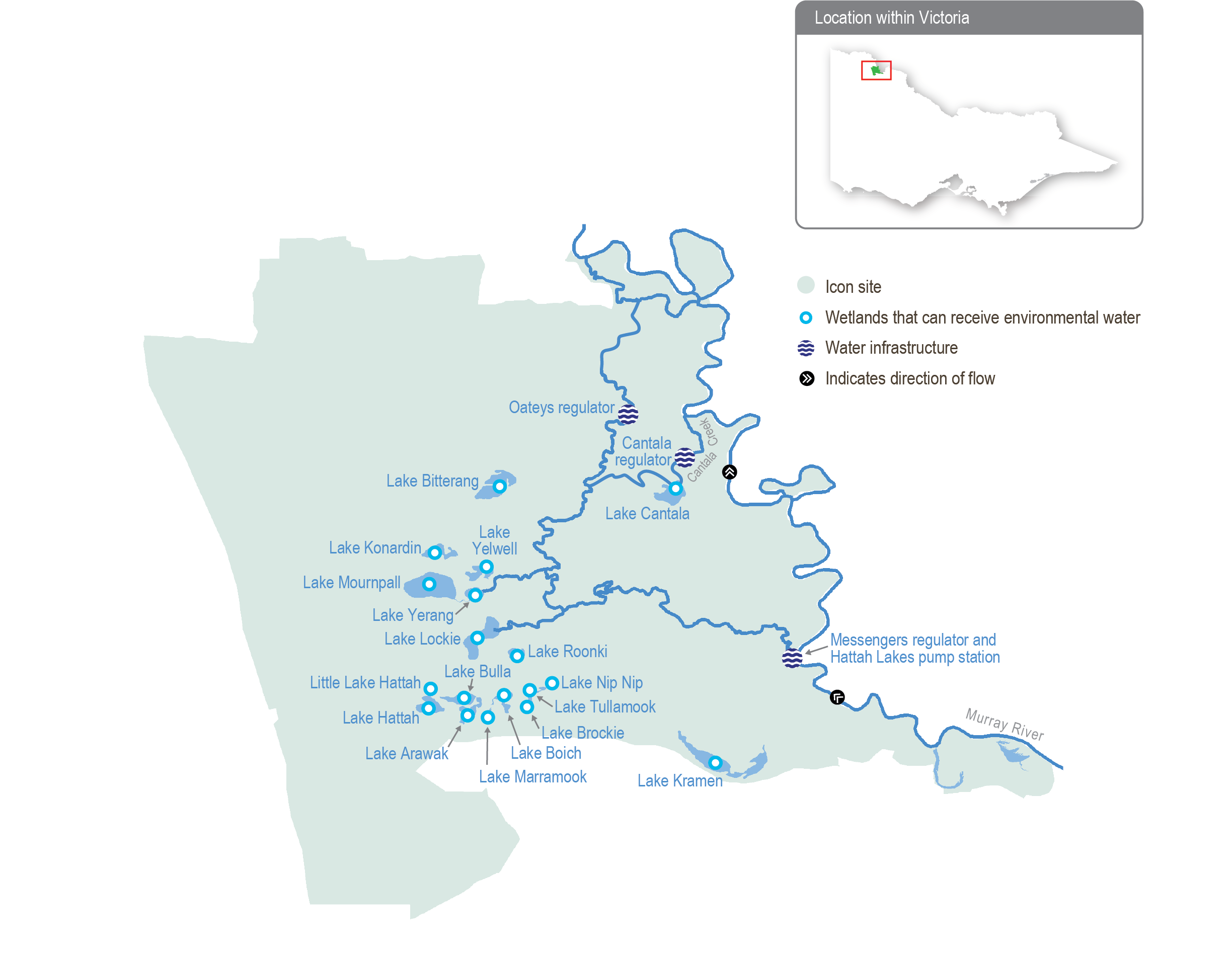On this page:
Latest information about where, when and why environmental water may be delivered to the Hattah Lakes and the environmental objectives being targeted is available in this year’s seasonal watering plan.
The seasonal watering plan also contains information about how environmental flows could support cultural, social, recreational and economic values in the Hattah Lakes.
Watering data for the Hattah Lakes and the wider northern region is updated quarterly. Visit current watering releases to find out more.
To find out the current environmental water entitlements held by the VEWH in the Hattah Lakes visit our water holdings.
Information about the ownership of water entitlements in the Hattah Lakes can be found under the Entitlements and Compliance section of the Murray basin page at Victorian Water Accounts.
The Hattah Lakes are part of the Victorian Murray system.
Traditional Owners
Traditional Owners with an interest in the Hattah Lakes include Latji Latji, Latji Latji Mumthelang, Tati Tati Kaiejin, Tati Tati Land and Water, Wadi Wadi Land and Water, Murray Valley Aboriginal Corporation, Gilby, Dadi Dadi Weki Weki, Culpra Millee, Nyeri Nyeri and Munatunga Elders.
System overview
The Hattah-Kulkyne National Park is in north-west Victoria, adjacent to the Murray River. The national park contains a complex of more than 20 semi-permanent freshwater lakes known collectively as the Hattah Lakes.
The Murray River’s flooding regimes strongly influence the Hattah Lakes’ environment and the surrounding floodplain. The system fills when there is a high flow in the Murray River, and some lakes hold water for several years after floods recede. Regulation of the Murray River has significantly reduced the frequency and duration of small to medium natural floods in the Hattah Lakes system. Over time, this has degraded vegetation communities and reduced the diversity and abundance of animals that use the vegetation and wetlands for habitat and food.
The Hattah Lakes complex can be broadly divided into the southern Hattah Lakes, which contain permanent to semi-permanent wetlands, and the higher-elevation northern Hattah Lakes, which are mostly episodic wetlands.
The Messenger, Oateys and Cantala regulators allow water to flow between the Murray River and the Hattah Lakes. When the flow in the Murray River is about 26,000 ML per day, water begins to flow through the Messengers regulator into Chalka Creek and through the Hattah Lakes complex. A permanent pump station can deliver up to 1,000 ML per day to the southern Hattah Lakes through Chalka Creek independently of the flow in the Murray River. The regulators and pump station are used in combination with several small constructed levees to deliver a pattern of flooding to the lakes system that is recommended to improve environmental outcomes. Lake Kramen is in the southeast of Hattah-Kulkyne National Park and is disconnected from the main Hattah Lakes complex. The Hattah Lakes pump station can deliver up to 145 ML per day to Lake Kramen. New infrastructure proposed under the Victorian Murray Floodplain Restoration Project will allow water to reach additional wetlands and floodplain areas in the northern Hattah Lakes.
Environmental values
Hattah Lakes is home to a diverse range of flood-dependent vegetation that changes with the landscape’s topography. Vegetation types range from wetland communities in low-lying areas that require almost annual flooding to lignum and black box communities situated higher on the floodplain that only need flooding once every four to five years (on average).
A combination of natural flooding and the delivery of environmental flows since 2010 has improved tree canopy health and recruitment of black box and river red gum communities throughout the Hattah Lakes. Woodland birds, including the endangered regent parrot, have benefitted from improved tree health.
Hattah Lakes provides important waterbird breeding sites in an arid landscape. A total of 34 species of waterbirds are known to breed at the lakes when conditions are suitable. Another six species of waterbirds breed in the surrounding floodplain.
Wetland drought refuge sites are limited in the region, making the Hattah Lakes critically important for water-dependent plants, waterbirds and terrestrial animals during dry periods.
The Hattah Lakes support large-bodied native fish species (such as golden perch) and small-bodied wetland species (such as carp gudgeon). Fish move between the lakes and the Murray River when the flow is suitable. They also persist in wetlands that retain water in the Hattah Lakes during dry years before re-dispersing during floods.
Page last updated: 29/07/25
